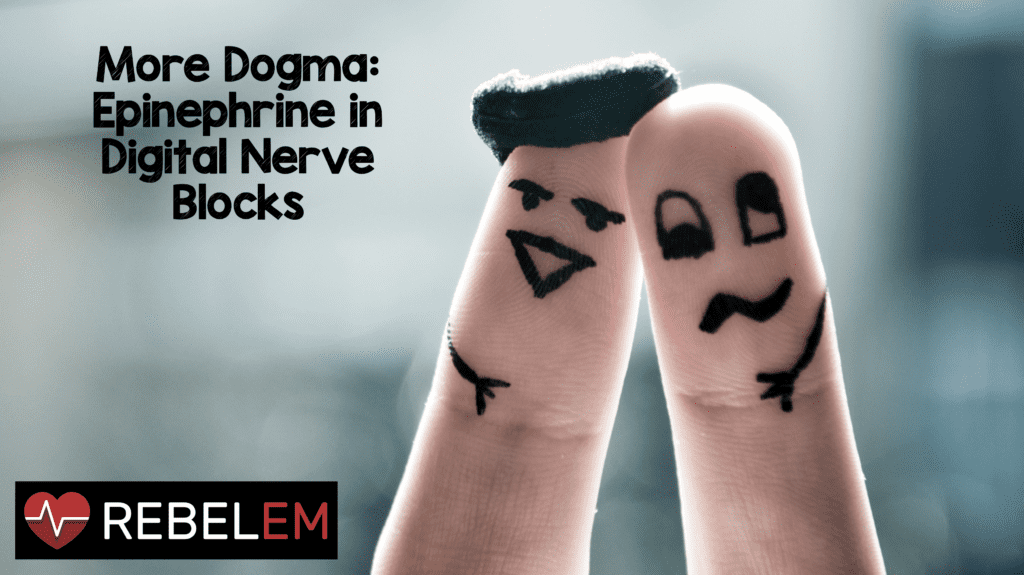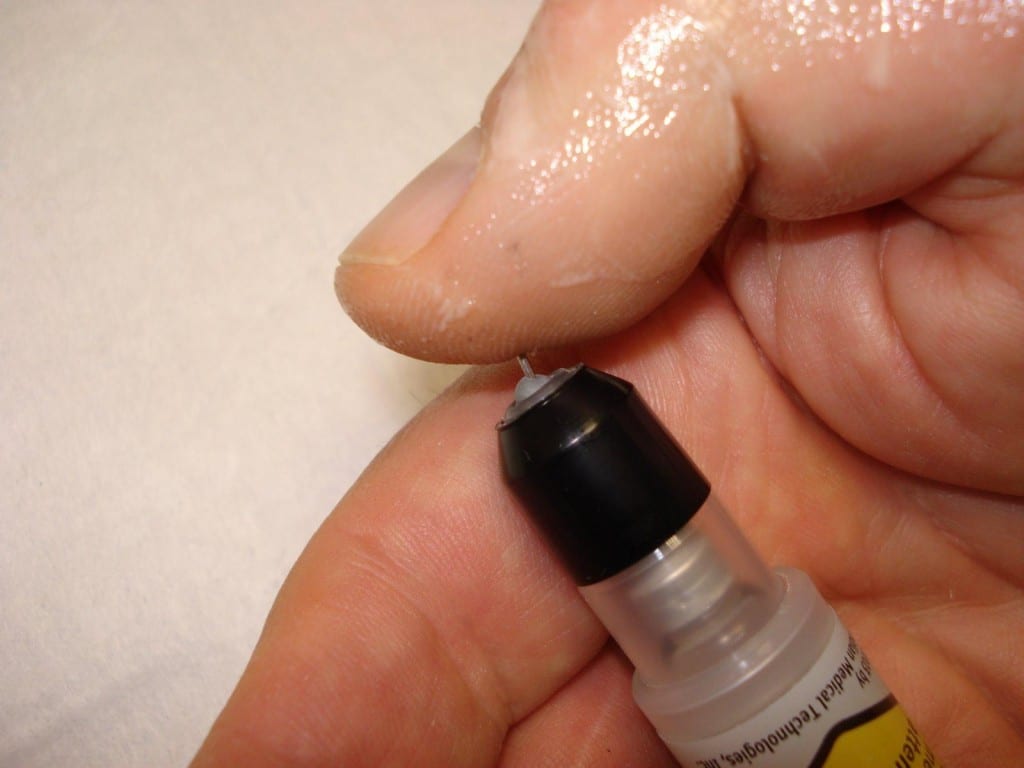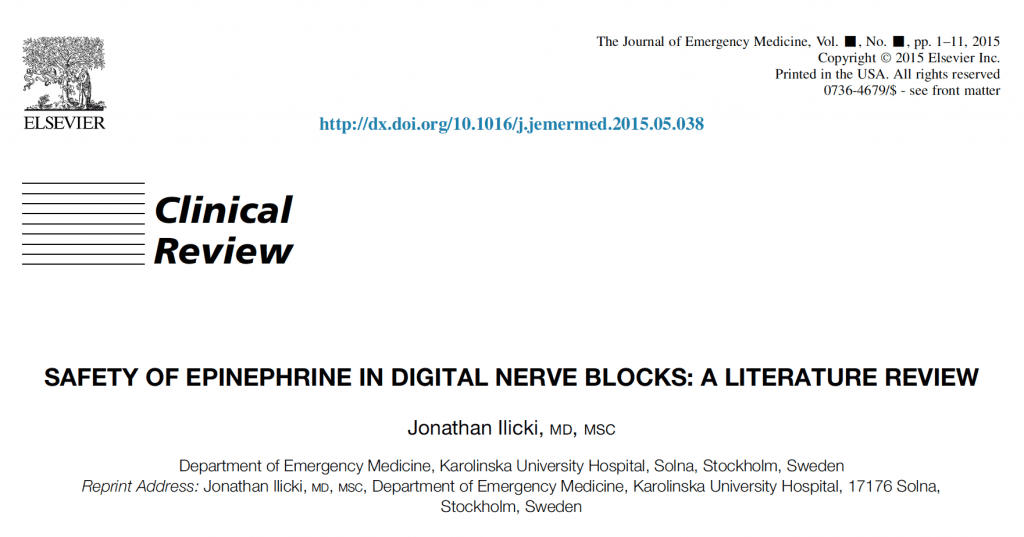
 You are working as an EM resident and have just evaluated a patient with a right long finger DIP joint dislocation. You perform a digital nerve block with 1% lidocaine with 1:100,000 epinephrine, and go to present to your attending before attempting the reduction. Your attending, on hearing about the epinephrine use goes berserk, and says “don’t you know that you shouldn’t use epi in fingers, noses, ears and toes?”.
You are working as an EM resident and have just evaluated a patient with a right long finger DIP joint dislocation. You perform a digital nerve block with 1% lidocaine with 1:100,000 epinephrine, and go to present to your attending before attempting the reduction. Your attending, on hearing about the epinephrine use goes berserk, and says “don’t you know that you shouldn’t use epi in fingers, noses, ears and toes?”.
When confronted with this situation we all like to have a one stop valid literature review to produce that validates our practice. Several social media authors have weighed in on this topic, however blogs sometimes don’t cut it for those unfamiliar with the current quality of peer reviewed online content.
The use of epinephrine in digital nerve blocks has been shown to increase duration of action for the anesthetic, and to allow the avoidance of bupivacaine, thereby decreasing the pain of the injection. (REBEL flashback)
Previous FOAM coverage:
- FOAMCast: episode-14-hand
- SMART EM: Smart Pseudoaxioms 1 – The Digital Axiom
- David Newman article in annals of emergency medicine: [1] (not open access)
A recent comprehensive lit review on this topic by Jonathan Ilicki was e-published in the Journal of Emergency Medicine on Aug 4, 2015 that satisfactorily provides a one stop valid literature review on this topic. [2]
The review article summarizes the available evidence for the safety of epinephrine in digital nerve blocks, and provides a ‘one stop shop’ article for those needing a traditional myth debunking in the published literature.
This post serves as a brief summary of the review article, I strongly recommend obtaining a copy of the article yourself, to have available the next time someone questions your practice.
The article discusses epinephrine issues under three broad headings:
- The origins of the idea that epinephrine is dangerous
- Safety of epinephrine in patients with normal peripheral circulation
- Safety of epinephrine in patients with risk for poor peripheral circulation
The origins of the idea that epinephrine is dangerous
- 50 case reports between 1889 and 1949 describing finger necrosis, only 21 used epi.
- Unknown epi concentration in 17 of the 21 cases.
- No reported cases since 1948 since the advent of commercial mixtures of lidocaine with epinephrine. (DO NOT MIX YOUR OWN EPI & LIDO SOLUTIONS)
Safety of epinephrine in patients with normal peripheral circulation
Physiological studies:
- 5 studies looking at the physiology of epinephrine in digital nerve blocks:
- 20-100 patients per study
- Decrease perfusion for 10 min to 60 min. Normal perfusion by 1-3 hours.
- One study used capillary blood gas assessments and showed an INCREASE in fingertip pH (7.395 to 7.403) [3] and no change in pCO2 and HCO3.
Retrospective studies:
- 7 studies showed no complications with the use of epinephrine with between 43 and 200,000 patients per study. Some of these studies included toe, and forefoot injections.
Prospective studies:
- 2 studies with 23 and 1340 cases showed no evidence of ischemia or necrosis.
Number of blocks performed without complication:
Excluding the studies with nebulous participant size, a total of 2797 digital nerve blocks are reported in 23 studies. NO complications attributable to the use of epinephrine.

Accidental high dose injection of epinephrine
- Epinephrine formulations currently available for local anesthesia are 1:100,000 and 1:200,000.
- One review examines 59 cases of epinephrine auto injector accidental injection of 1:1000 epinephrine into fingers.
- 32 cases did not receive any reversal agent to treat any potential epinephrine induced vasoconstriction. [4] There were no cases of ischemia.
- Another review describes 127 patients with accidental injection(Only 23% received pharmacological treatment). In the four cases with documented ischemia, 2 of them resolved within 2 hours. [5]
- The author of the review correctly points out that with no necrosis in the patients exposed to 100 times the dose of epinephrine we are considering using in intentional digital nerve block injections that there should be no safety issue.
- Phentolamine was found to decrease the duration of epinephrine induced vasoconstriction (319 down to 85 min). [6] Duration was based on visual pallor, rather than any physiological measurement.

Safety of epinephrine in patients with risk for poor peripheral circulation
This is an area where there is less hard data, and that can make the epi-liberal digital nerve blockers amongst us a little more nervous.
Previously described high risk populations include those patients with:
- Uncontrolled hypertension
- Pheochromocytoma
- Hyperthyroidism
- Poor digital circulation
- Peripheral Vascular Disease
- Diabetes
Two potential harms need to be considered when using epinephrine containing solutions in this population. The first is the risk of intravascular injection of epinephrine in a patient with vascular risk factors such as hyperthyroidism, hypertension, or coronary artery disease. The second is the potential harm to a finger with poor circulation that has to endure additional hypoperfusion from epinephrine induced vasoconstriction.
There are no reported cases of harm from either of these theoretical mechanisms.
- A postmortem study assessing the digital artery responses to norepinephrine showed a DECREASE in constriction in the arteries of hypertensive patients. [7]
- A 2009 study reports on the injection of 59 fingers and 4 toes of a patient group with a 64% rate of hypertension, 28% rate of DM type II, 51% with anticoagulant use. 3% of these patients were smokers. [8] This study performed local infiltration of anesthetic agent, rather than digital nerve blocks.
- Two other studies included smokers without significant signs of digital ischemia, and patient with hypertension, coronary artery disease, and diabetes and again found no episodes of ischemia or necrosis.
Clinical Bottom Line:
- In patients with no cardiovascular risk factors the use of epinephrine in digital nerve blocks is SAFE
- In patients with cardiovascular risk factors the use of epinephrine in digital nerve blocks is PROBABLY SAFE
- If you have a patient with bilateral BKA’s who still smells strongly of his last cigarette, consider holding the epinephrine
- If you do have a patient with severe signs of ischemia phentolamine can be used to reverse the epinephrine induced ischemia
- The article reviewed in this post is a worthwhile read, and will provide any trainee with adequate rebuttal if the are ever rebuked by their supervising clinician for using epinephrine in a digital nerve block
References:
- Newman DH et al. Truth, and Epinephrine, at our Fingertips: Unveiling the Pseudoaxioms. Ann Emerg Med 2007. PMID: 17719691
- Ilicki J. Safety of Epinephrine in Digital Nerve Blocks: A Literature Review. J Emerg Med 2015. PMID: 26254284
- Sonmez A et al. Digital Blocks with and Without Adrenalin: A Randomized-Controlled Study of Capillary Blood Parameters. J Hand Surg Eur 2008. PMID: 18687842
- Fitzcharles-Bowe C et al. Finger Injection with High-Dose (1:1,000) Epinephrine: Does it Cause Finger Necrosis and Should it be Treated? Hand (N Y) 2007. PMID: 18780041
- Muck AE et al. Six Years of Epinephrine Digital Injections: Absence of Significant Local or Systemic Effects. Ann Emerg Med 2010. PMID: 20346537
- Nodwell T et al. How Long Does it Take Phentolamine to Reverse Adrenaline-Induced Vasoconstriction in the Finger and Hand? A Prospective, Randomized, blinded Study: The Dalhousie Project Experimental Phase. Can J Plast Surg 2003. PMID: 24009436
- Moulds RF. Reduced Responses to Noradrenaline of Isolated Digital Arteries from Hypertensives. Clin Exp Pharmacol Physiol 1980. PMID: 7449191
- Firoz B et al. Local Anesthesia Using Buffered 0.5% Lidocaine with 1:200,000 Epinephrine for Tumors of the Digits Treated with Mohs Micrographic Surgery. J Am Acad Dermatol 2009. PMID: 19751881
Post Peer Reviewed By: Salim Rezaie (Twitter: @srrezaie)
The post More Dogma: Epinephrine in Digital Nerve Blocks appeared first on REBEL EM - Emergency Medicine Blog.

